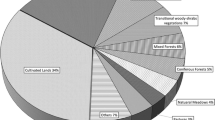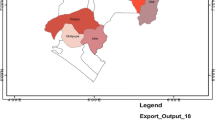Abstract
This study analyzed adoption of agroforestry technologies in the central highlands of Ethiopia. A binary logistic regression model was used based on a survey of 96 adopters and non-adopter farmers. The results showed that all the farmers had a positive perception of agroforestry technology and that farmland boundaries were the most widely adopted agroforestry technology (81%), followed by farmland tree planting (71%). Alley cropping was the least preferred agroforestry technology by farmers (11%), followed by garden agroforestry technology (37%). Agroforestry was perceived as a major contributor to various products and improved soil fertility by 29% and 28%, respectively, of the farmers. Family size and customary rules are significant determinants of agroforestry technology adoption (p < 0.01). Access to extension services was also significantly correlated with the adoption of agroforestry technology (p < 0.05). Adoption of agroforestry technologies is important to address the continuous depletion of forest resources and improve the livelihood of farmers. The potential influence of these determinant factors should be taken into account when identifying suitable agroforestry technologies.

Similar content being viewed by others
Data availability
The data used to support the findings of this study are included within the article.
References
Abay KA, Berhane G, Taffesse AS, Koru B, Abay K (2016) Understanding farmers’ technology adoption decisions: input complementarity and heterogeneity. International Food Policy Research Institute, Washington, p 22
Abdella M, Cheneke B, Elema R (2022) Assessment of existing agroforestry practices in East Hararghe zone Oromia, Ethiopia
Adam AM (2020) Sample size determination in survey research. J Sci Res Rep 26(5):90–97. https://doi.org/10.9734/JSRR/2020/v26i530263
Adane F, Legesse A, Weldeamanuel T, Belay T (2019) The contribution of a fruit tree-based agroforestry system for household income to smallholder farmers in Dale district, Sidama zone, Southern Ethiopia. Adv Plants Agric Res 9(1):78–84
Ahmad S, Xu H, Ekanayake E (2023) Socioeconomic determinants and perceptions of smallholder farmers toward agroforestry adoption in Northern irrigated plain, Pakistan. Land 12(4):813
Akter R, Hasan MK, Kabir KH, Darr D, Roshni NA (2022) Agroforestry systems and their impact on livelihood improvement of tribal farmers in a tropical moist deciduous forest in Bangladesh. Trees, for People 1(9):100315
Alemayehu A, Bewket W (2017) Smallholder farmers’ coping and adaptation strategies to climatic change and variability in central highlands of Ethiopia. Local Environ 22(7):825–839
Alemayehu A, Bewket W (2018) Trees and rural households’ adaptation to local environmental change in the central highlands of Ethiopia. J Land Use Sci 13(1–2):130–145
Amare D, Wondie M, Mekuria W, Darr D (2019) Agroforestry of smallholder farmers in Ethiopia: practices and benefits. Small-Scale for 18(1):39–56
Awe F, Oguntoye TO, Olatunji BT (2021) Determinants of farmers’ adoption of agroforestry technology in Ibarapa area of Oyo state, Nigeria. J Agric Food Sci 19(1):189–200
Berger D (2017) Introduction to binary logistic regression and propensity score analysis. ResearchGate, Berlin, pp 1–30
Brown WM, Ferguson SM, Viju-Miljusevic C (2020) Farm size, technology adoption and agricultural trade reform: evidence from canada. J Agric Econ 71(3):676–697
Challa M, Tilahun U (2014) Determinants and impacts of modern agricultural technology adoption in west Wollega: the case of Gulliso district. J Biol, Agric Healthc 4(20):63–77
Chemura A, Yalew AW, Gornott C (2021) Quantifying agroforestry yield buffering potential under climate change in the smallholder maize farming systems of Ethiopia. Front Agronom 3:609536
Coulibaly JY, Chiputwa B, Nakelse T, Kundhlande G (2017) Adoption of agroforestry and the impact on household food security among farmers in Malawi. Agric Syst 155:52–69
CSA (Central Statistical Agency) (2021) Population projection of Ethiopia for all regions at the Woreda level. The Federal Democratic Republic of Ethiopia, Addis Ababa
Deressa T, Hassan R, Ringler C, Alemu T, Yesuf M (2009) Determinants of farmers’ choice of adaptation methods to climate change in the Nile Basin of Ethiopia. Glob Environ Change 19:248–255
Dessie G, Erkossa T (2011) Planted forests and trees working papers eucalyptus in east Africa socioeconomic and environmental issues (Working Paper FP46/E FAO). Rome, Italy
Dhakal A, Rai RK (2020) Who adopts agroforestry in a subsistence economy?—Lessons from the Terai of Nepal. Forests 11(5):565
Dhyani SK, Kareemulla K, Handa AK (2009) Agroforestry potential and scope for development across agro-climatic zones in India. Indian J for 32(2):181–190
Duffy C, Toth GG, Hagan RP, McKeown PC, Rahman SA, Widyaningsih Y, Sunderland TC, Spillane C (2021) Agroforestry contributions to smallholder farmer food security in Indonesia. Agrofor Syst 95(6):1109–1124
Fadeyi OA, Ariyawardana A, Aziz AA (2022) Factors influencing technology adoption among smallholder farmers: a systematic review in Africa
FDRE (Federal Democratic Republic of Ethiopia) (2011) Climate resilient green economy: mission statement. FDRE, Addis Ababa
Getnet D, Mekonnen Z, Anjulo A (2023) The potential of traditional agroforestry practices as nature-based carbon sinks in Ethiopia. Nat-Based Solut 4:100079
Headey D, Dereje M, Taffesse AS (2014) Land constraints and agricultural intensification in Ethiopia: a village-level analysis of high-potential areas. Food Policy 1(48):129–141
Jahan H, Rahman MW, Islam MS, Rezwan-Al-Ramim A, Tuhin MM, Hossain ME (2022) Adoption of agroforestry practices in Bangladesh as a climate change mitigation option: investment, drivers, and SWOT analysis perspectives. Environ Chall 1(7):100509
Jose S (2019) Environmental impacts and benefits of agroforestry. In Oxford research encyclopedia of environmental science.
Kassie GW (2016) Agroforestry and land productivity: evidence from rural Ethiopia. Cogent Food Agric 2:1
Leakey R (1996) Definition of agroforestry revisited. Agrofor Today 8:5–5
Lewetegn A (2019) Impact of rural household’s fuel wood consumption on forest resources in Tarmaber Woreda, North Shewa Zone, Amhara National Regional State (MA Thesis)
Liliane M, Ezekiel N, Gathuru G (2020) Socioeconomic and institutional factors affecting smallholders farmers to adopt agroforestry practices in southern province of Rwanda. Int J Agric Sci Food Technol 6(1):068–074
Mahmood MI, Zubair M (2020) Farmer’s perception of and factors influencing agroforestry practices in the Indus river Basin, Pakistan. Small-Scale for 19(1):107–122
Masebo N, Menamo M (2016) A review paper on the role of agroforestry for rehabilitation of degraded soil. Biology, Agriculture and Healthcare 6(5):128–136
Massresha SE, Lema TZ, Neway MM, Degu WA (2021) Perception and determinants of agricultural technology adoption in north shoa zone, amhara regional state, Ethiopia. Cogent Econ Financ 9(1):1956774
Mbow C, Smith P, Skole D, Duguma L, Bustamante M (2014) Achieving mitigation and adaptation to climate change through sustainable agroforestry practices in Africa. Curr Opin Environ Sustain 6:8–14
Mengesha A, Mansberger R, Damyanovic D, Stoeglehner G (2019) Impact of land certification on sustainable land use practices: case of Gozamin District, Ethiopia. Sustainability 11(20):5551
Meseret D (2016) Land degradation in Amhara region of Ethiopia: review on extent, impacts and rehabilitation practices. J Environ Earth Sci 6(1):120–130
Milkias D, Abdulahi A (2018) Determinants of agricultural technology adoption: the case of improved highland maize varieties in Toke Kutaye District, Oromia Regional State, Ethiopia. J Invest Manag 7(4):125–132
Minang PA, Duguma LA, Bernard F, Mertz O, van Noordwijk M (2014) Prospects for agroforestry in REDD+ landscapes in Africa. Curr Opin Environ Sustain 1(6):78–82
Molla A, Kewessa G (2015) Woody species diversity in traditional agroforestry practices of Dellomenna district, Southeastern Ethiopia: implication for maintaining native woody species. Int J Biodiv 2(iii):1–3
Mukhlis I, Rizaludin MS, Hidayah I (2022) Understanding socio-economic and environmental impacts of agroforestry on rural communities. Forests 13:556
Mulu S (2009) Assessment on farmers’ perception and adoption of agroforestry technologies in south Wello, north east Ethiopia (Doctoral dissertation, MSc thesis, Wondo Genet College of Forestry and Natural Resources)
Mwase W, Sefasi A, Njoloma J, Nyoka BI, Manduwa D, Nyaika J (2015) Factors affecting adoption of agroforestry and evergreen agriculture in Southern Africa. Environ Nat Resour Res 5(2):148
Ndalama E, Kamanga-Thole G, Missanjo E (2015) Agroforestry contribution to the improvement of rural community livelihoods in Balaka, Malawi. Int J for Hortic 1(1):5–11
Plieninger T, Muñoz-Rojas J, Buck LE, Scherr SJ (2020) Agroforestry for sustainable landscape management. Sustain Sci 15(5):1255–1266
Ruba UB, Talucder MSA (2023) Potentiality of homestead agroforestry for achieving sustainable development goals: Bangladesh perspectives. Heliyon 9:e14541
Samuel O, Sylvia S (2019) Adoption of agroforestry practices and climate change mitigation strategies in North West province of South Africa. Int J Clim Change Strateg Manag 11(5):716–729
Telwala Y (2023) Unlocking the potential of agroforestry as a nature-based solution for localizing sustainable development goals: a case study from a drought-prone region in rural India. Nat-Based Solut 3:100045
Tilahun A (2012) Floristic composition, structure and regeneration status of Wof Washa forest in North Shewa Zone. Unpublished report, Debre Birhan University, Ethiopia
Tsegaye NT (2023) The impact of agroforestry practice on forest conservation and community livelihood improvement: a case of Buno Bedele Zone of west Ethiopia’s Chora district. Environ Sustain Indic 17:100229
Von Breitenbach F (1961) Exotic trees in Ethiopia. Ethiop for Rev 2:19–38
Zegeye MB, Meshesha GB, Shah MI (2022) Measuring the poverty reduction effects of adopting agricultural technologies in rural Ethiopia: findings from an endogenous switching regression approach. Heliyon 8(5):e09495
Acknowledgements
The authors would like to thank the participants of this study.
Funding
This study received no funding.
Author information
Authors and Affiliations
Contributions
Conceptualization: AA, SS. Methodology: AA, SS. Data collection: SS. Analysis, Interpretation and Writing: AA, SS. Figure preparation: AA. All authors read and approved the final manuscript.
Corresponding author
Ethics declarations
Conflict of interest
The authors declare no competing interests.
Ethical approval and consent to participate
This article does not contain any studies with human participants or animals performed by the author.
Consent for publication
Not applicable.
Additional information
Publisher's Note
Springer Nature remains neutral with regard to jurisdictional claims in published maps and institutional affiliations.
Rights and permissions
Springer Nature or its licensor (e.g. a society or other partner) holds exclusive rights to this article under a publishing agreement with the author(s) or other rightsholder(s); author self-archiving of the accepted manuscript version of this article is solely governed by the terms of such publishing agreement and applicable law.
About this article
Cite this article
Alemayehu, A., Simeneh, S. Adoption of agroforestry technologies: a case study from central highlands of Ethiopia. Agroforest Syst 98, 1021–1034 (2024). https://doi.org/10.1007/s10457-024-00972-1
Received:
Accepted:
Published:
Issue Date:
DOI: https://doi.org/10.1007/s10457-024-00972-1




